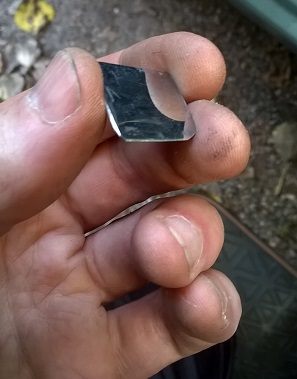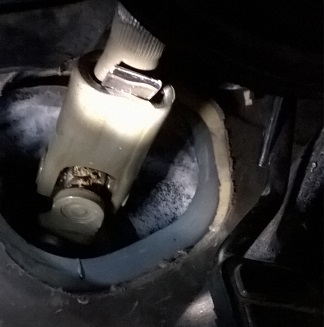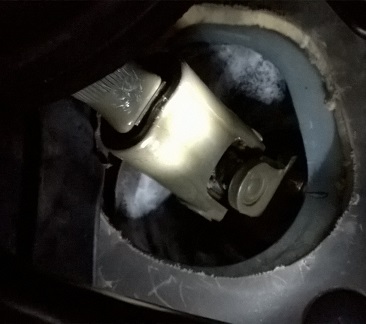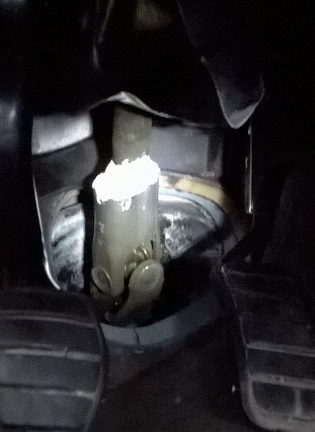Renault Clio Steering U/J
Discussion
chevy55 said:
Sorry, I thought you wanted to bodge it, welding is a safer bodge than wedging bits of metal in it. If you're too tight arsed to buy a new column why not do everyone a favour and scrap the car and make the roads in your vicinity safer. 
Apart from, as already stated, an MOT inspector is well within their right to fail it. Given this is a common enough fault, they may well check this. On possible way around this would be to drill the sides and use rosette welds which would be pretty much invisible once cleaned up, and probably a safer way of doing things as you aren't introducing a HAZ around the circumference of the shaft.
I agree that, correctly welded, it is would be fine but the alternative repairs (shimming etc.) are not unsafe and won't cause MOT problems.
As someone driving an old British sports car and an even older American land barge it seems a little hypocritical to talk about safety, or do both of those stop and steer as well as a modern car?
Edited by Mr2Mike on Saturday 27th August 22:27
So, now this project has moved forward. I cut out two shims from the blade of a table knife, and rounded the edges with a file. Then I just tapped them in to fill out the excess space in the joint. Since the size of the shims was measured to completely go in to the notch, the shape of the column end will probably be enough to keep the shims from popping out of the UJ. Anyway, I'll still try to find some way to double-secure that they won't fall out. Ideas are welcome.
I haven't done a test drive yet, but by turning the wheel with the car standing still, this bodge seems to have taken out the free play completely, at least for now.

The shim, measured and shaped

Halfway in.

All the way in. Since the column end thickens outside the UJ, the shim will probably not fall out. Still I'll try to figure a way to double secure it. Maybe a simple hose clamp would do the trick?
Here's an edit:
 |http://thumbsnap.com/3rAVqcui[/url]
|http://thumbsnap.com/3rAVqcui[/url]
I now tried to seal the whole thing with some flexible glue, and also fill out the remaining excess space inside the notch. Looks a bit messy, since it's in a really awkward position, where it's difficult to do a perfect job. Anyway, the theory is that the steel shims will prevent the free play, and therefore has to withstand the biggest strains, while the flexible glue prevents the shims from moving around too much. Probably strains will cause the shims to move out of their current positions sooner or later (though now they're fitted really tight), but with this fix I hope it will rather be later than sooner.
I haven't done a test drive yet, but by turning the wheel with the car standing still, this bodge seems to have taken out the free play completely, at least for now.

The shim, measured and shaped

Halfway in.

All the way in. Since the column end thickens outside the UJ, the shim will probably not fall out. Still I'll try to figure a way to double secure it. Maybe a simple hose clamp would do the trick?
Here's an edit:
 |http://thumbsnap.com/3rAVqcui[/url]
|http://thumbsnap.com/3rAVqcui[/url]I now tried to seal the whole thing with some flexible glue, and also fill out the remaining excess space inside the notch. Looks a bit messy, since it's in a really awkward position, where it's difficult to do a perfect job. Anyway, the theory is that the steel shims will prevent the free play, and therefore has to withstand the biggest strains, while the flexible glue prevents the shims from moving around too much. Probably strains will cause the shims to move out of their current positions sooner or later (though now they're fitted really tight), but with this fix I hope it will rather be later than sooner.
Edited by Axelvilhelm on Friday 30th September 14:13
Took her out for a good test ride today: No play at all! Felt really good to drive, much safer than before. Time will tell if this is a long term fix.
I think the secret is to use shims that are strong enough, and of the right size. If they are too thin, they will not fit tight enough to take out all the free play (and might not stay in place), and if they are too weak, they might deform and/or break. If glue is used to secure the shims, it should be flexible, or otherwise strains and vibrations might cause it to break eventually.
I think the secret is to use shims that are strong enough, and of the right size. If they are too thin, they will not fit tight enough to take out all the free play (and might not stay in place), and if they are too weak, they might deform and/or break. If glue is used to secure the shims, it should be flexible, or otherwise strains and vibrations might cause it to break eventually.
one eyed mick said:
Bodgery I personaly would never drive it !!
Fair enough. Is that simply because it is bodgery, and that is wrong as such, or is there any specific reason why you think it is unsafe? If you're familiar with the discussion and images posted previously in this thread, and have some level of understanding in mechanics and engineering, I'd expect you're able to point out exactly how this diy repair could cause a fatal failure.As far as I can understand, apart from replacing with a new part, shimming is the only repair with no risk of making the original parts weaker, right? And if the original parts aren't weakened, what other possibilities are there for a sudden fatal failure? It would be fair to inform me, if there's something I missed out on, since I don't want to die.
Gassing Station | Suspension, Brakes & Tyres | Top of Page | What's New | My Stuff


